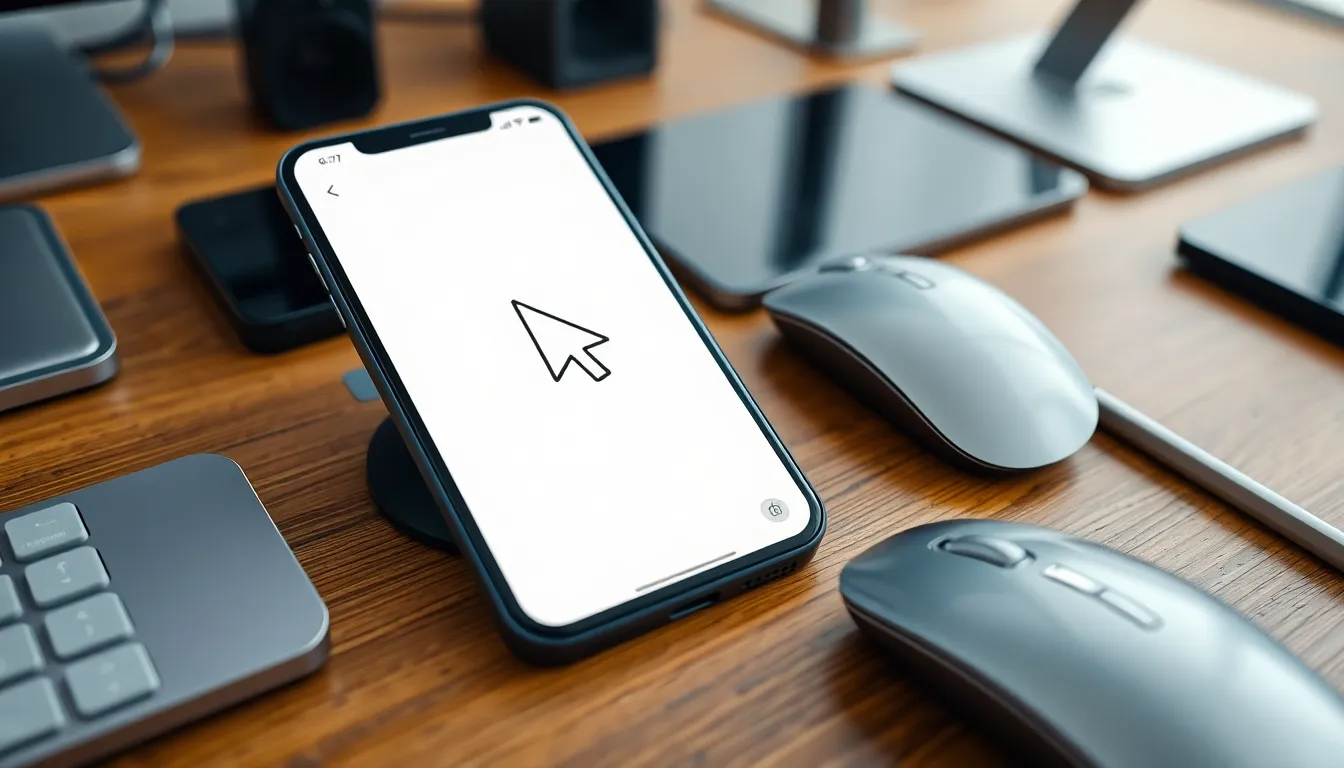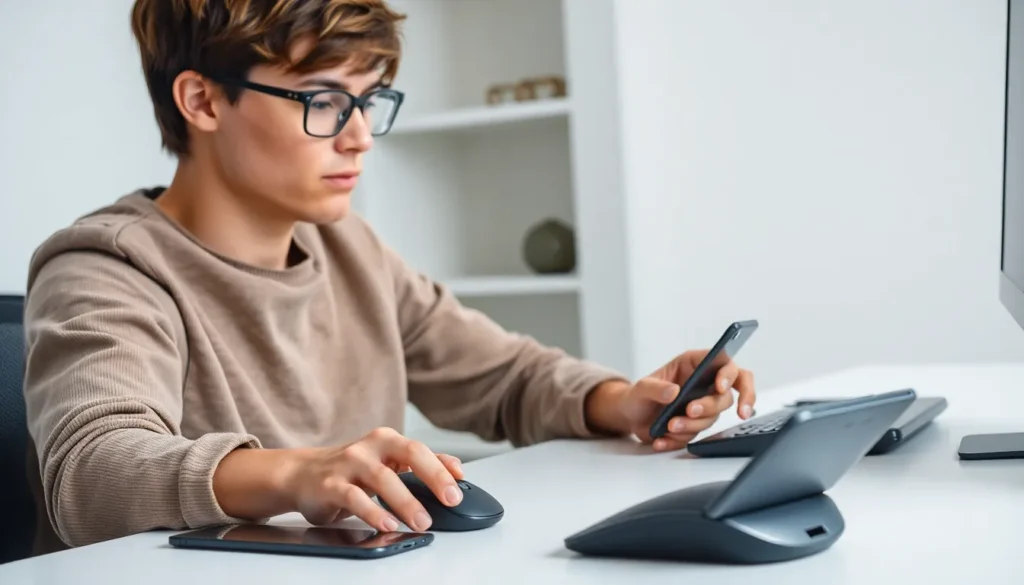Table of Contents
TogglePicture this: you’re trying to navigate your iPhone like a pro, but your fingers just aren’t cutting it. Wouldn’t it be great if you could connect a mouse and unleash your inner tech wizard? Well, hold onto your hats because the answer might just surprise you!
Overview of Mouse Connectivity
Connecting a mouse to an iPhone broadens the ways users can interact with their devices. Apple’s iOS supports mouse connectivity through Bluetooth or USB connections, enhancing accessibility and navigation. Users must ensure their device has iOS 13 or later to make this connection possible.
Bluetooth mice pair easily with iPhones. First, users enable Bluetooth in the device settings. Next, they put the mouse into pairing mode. Once the iPhone detects the mouse, it displays on the screen for selection. A successful connection allows full use of the mouse for navigation purposes with smooth cursor movement.
USB mice offer another option, but different requirements exist. Utilizing the Lightning to USB adapter allows users to connect directly. After connecting the mouse, iPhones recognize it instantly, enabling features similar to Bluetooth connectivity. This option tends to work well for those with a wired mouse, ensuring stable performance during use.
Users notice effective navigation improvements when incorporating a mouse. By connecting a mouse, they can click, scroll, and select items with greater efficiency. The experience mirrors that of using a laptop, providing a familiar interface for those accustomed to traditional computing devices.
Some users may encounter challenges, especially with mouse tracking settings. Adjustments can occur in the Accessibility settings under Pointer Control. Fine-tuning options like cursor size and speed ensures an optimized experience tailored to individual preferences. Overall, connecting a mouse to an iPhone presents a viable solution for enhanced user interaction.
Compatibility of Mice with iPhone

Connecting a mouse to an iPhone enhances navigation and improves user experience. Both wired and wireless options are compatible with iPhones running iOS 13 or later.
Wired Mouse Connection
Using a wired mouse requires a Lightning to USB adapter. This adapter allows users to plug in their USB mouse directly into the iPhone. A wired connection offers stable performance, ensuring consistent cursor movement. Compatibility exists across various USB mice, providing users with versatility in choosing equipment. Many find that navigating through apps and settings feels more intuitive with physical clicks. Adjustments in the Accessibility settings may be necessary for optimal tracking.
Wireless Mouse Connection
Pairing a wireless mouse involves enabling Bluetooth on the iPhone. Users can search for available devices, select their mouse, and establish the connection quickly. Most Bluetooth mice function seamlessly, giving users smooth control as they navigate. They offer freedom of movement and often come with additional features, such as customizable buttons. The setup process is straightforward, leading to an enjoyable navigation experience. Accessibility settings can further enhance control and responsiveness.
How to Connect a Mouse to iPhone
Connecting a mouse to an iPhone enhances navigation and accessibility. Users can choose between Bluetooth and USB connections.
Using Bluetooth
To connect a Bluetooth mouse, start by enabling Bluetooth on the iPhone. Go to Settings, then Bluetooth, and toggle it on. Next, put the mouse in pairing mode, which usually involves holding down a button on the mouse. The iPhone will identify the mouse on the Bluetooth devices list. Once it appears, tap it to initiate pairing. After successful pairing, the cursor will appear on the iPhone screen, allowing for seamless navigation. Additional adjustments can be made in the Accessibility settings to customize the cursor speed and tracking.
Using USB Adapter
For a wired mouse, a Lightning to USB adapter is necessary. Connect the adapter to the iPhone’s Lightning port, then plug the mouse into the USB port of the adapter. The iPhone recognizes the mouse immediately, enabling cursor control for effortless navigation. Clicking and scrolling features function effectively, much like on a laptop. Users should check the Accessibility settings to fine-tune pointer control for improved responsiveness. This setup provides a reliable option for those preferring wired connections over Bluetooth.
Benefits of Using a Mouse with iPhone
Using a mouse with an iPhone enhances user experience. Cursor control becomes smoother and more intuitive, similar to that of laptops. Increased precision in navigation allows for quicker app interactions and selection of items.
Task efficiency improves significantly, especially for productivity-focused users. When working on documents or spreadsheets, clicking and scrolling with a mouse simplifies multitasking. Customization options, like adjusting cursor speed in Accessibility settings, further enhance individual usability.
Accessibility features benefit greatly from mouse connectivity. Users with mobility challenges find it easier to navigate their devices. The option to enlarge the cursor or adjust tracking settings often leads to a more tailored experience.
A mouse setup is typically straightforward and user-friendly. Connecting a Bluetooth mouse involves enabling Bluetooth and pairing the device quickly. Wired mice provide a stable connection with a Lightning to USB adapter, ensuring reliable performance.
Multiple types of mice are compatible with the iPhone, offering users flexibility. Whether stating a preference for wired or wireless options, each type meets different needs. These choices enhance overall interaction with the device.
User comfort often increases when using a mouse versus the touch screen alone. Streamlined navigation can lead to less fatigue during extended use. Overall, employing a mouse transforms the way individuals interact with their iPhones, opening new avenues for efficient use.
Potential Limitations and Considerations
Compatibility issues may arise with certain mouse models, particularly older or less common devices that don’t support Bluetooth or USB connections on the iPhone. Users should confirm whether their mouse meets the necessary specifications for iOS 13 or later functionality.
Latency can impact the experience when using a mouse, particularly with Bluetooth connections. Delays between cursor movement and actual response can diminish the overall performance, especially in tasks that require precision.
Customization options, while beneficial, might come with a learning curve. Users unfamiliar with Accessibility settings may need to spend time adjusting cursor speed and tracking to suit their preferred use. Finding the right balance can enhance navigation significantly.
Moreover, battery life on wireless mice poses a potential issue. Keeping track of battery levels and ensuring the mouse remains charged can prevent interruptions during use. Some may find this inconvenience outweighs the benefits of enhanced navigation.
App compatibility represents another consideration. Not all applications fully support mouse input, which can limit the effectiveness of this setup in certain tasks. Users may notice varying degrees of functionality depending on the app in use.
It’s essential to remember that not every user will prefer mouse navigation over traditional touch controls. Habits and preferences vary, and some individuals may find touch interactions more intuitive and responsive.
Updates in iOS may also introduce changes that influence mouse connectivity. Remaining informed about software updates ensures users can adapt to any new features or limitations that arise with future iOS versions.
Users should weigh these potential limitations and considerations carefully when deciding to connect a mouse to an iPhone. Each factor contributes to the overall user experience and should align with personal needs and preferences.
Connecting a mouse to an iPhone can significantly enhance navigation and accessibility. With options for both Bluetooth and USB connections users can enjoy a smoother experience that resembles traditional laptop usage. The ability to adjust settings in Accessibility allows for a tailored experience that caters to individual needs.
While there are potential limitations such as compatibility issues and latency challenges users can find that the benefits often outweigh these concerns. This feature opens up new possibilities for productivity and ease of use especially for those with mobility challenges. By exploring mouse connectivity users can discover a more efficient way to interact with their iPhones.







